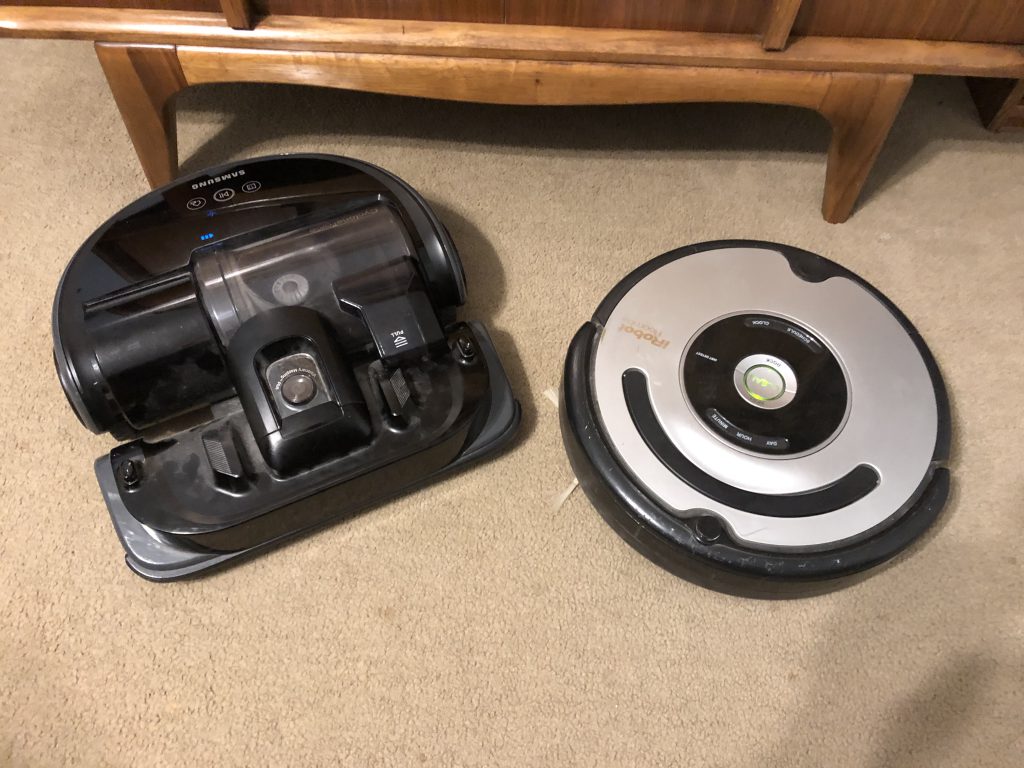Gifting Guide Day 12: Robotic Vacuums
As someone who spent a few summers as a professional cleaner, I now avoid it whenever possible. When the first Roomba robotic vacuum came out, I was skeptical but intrigued. I bought my first one in 2007. It was a Roomba 560, the third generation, and many of the kinks of earlier models had been fixed. I have been impressed, as that vacuum is still going strong. I’ve replaced the brushes, filters, and battery, but it still works as well as when I bought it. Over the years, I’ve added to my fleet of cleaning robots, including two Scoobas (robo mops) and a Samsung PowerBot9000. The Samsung is a better cleaner, but it has some problems charging, and getting reasonably priced parts is impossible.

While robotic vacuums are not as effective at cleaning as a push or canister vacuum, they are easy to use if you don’t have the time or ability to vacuum, and the way I see it, if you run the robot three times a week, your house will be much cleaner than if you only pull out the push vac once a month. Some of the higher-end models can even empty themselves.
One major caveat; if you have pets, you better be sure there hasn’t been an accident before the robot runs. It will make a mess and may damage the robot.
Some robots move methodically across the floor, leaving those nice straight vacuum lines (like my PowerBot). Others move randomly (like my Roomba) and leave a random pattern the carpet. There is no visual difference if you use on hard floors, but if you like lines, look for one that vacuums in a grid pattern.
Some vacuums have smartphone apps. I’ve never had one like that, but if you want to set your vacuum off from work, that might be a feature worth the price. Another feature is a scheduler. Before I had pets, I had the robot automatically vacuum a few times a day while working. Now that I have pets, that is a big no-no. Some robots work better on hard floors vs. carpet. Both the Samsung and Roomba I have worked fine on either surface. Another nice feature is side brushes. Side brushes will allow the robot to clean along the edge of the room and closer around furniture. My Roomba has side brushed, and my Samsung does not. There is a definite difference in that the side brushes definitely clean more area. I also like it when the vacuum can find its way back to the dock to recharge. Some robots, like the Roomba, need extra sensors (called a lighthouse) to find their ways back when it does multiple rooms. Another cool but pricy feature is automatic dust bin emptying into a docking station. I never minded emptying the dust bin, but if you find it difficult to do every time it runs, auto empty may be worth the price.
As I can’t possibly buy and review every piece of technology out there, I maintain a subscription to Consumer Reports to get an unbiased opinion on what the best products are each year.
Robotic vacuums vary in price from $200 to $1000. But the more expensive devices don’t always clean better. Some of the best ones, according to CR, include the Eufy RoboVac 11, the LG Hom-Bot CR5765, the Samsung Powerbot Limited Edition Darth Vader and Storm Trooper editions(Really? Where is Gonk?), and the Samsung Powerbot SR20H9051, the Ecovacs Deebot M88, and the tried and true iRobot Roomba S9+. The prices on these robots run from $250 to $900, depending on features.
I highly recommend finding a good robotic vacuum. Just be sure to pick one that has the features you need.


